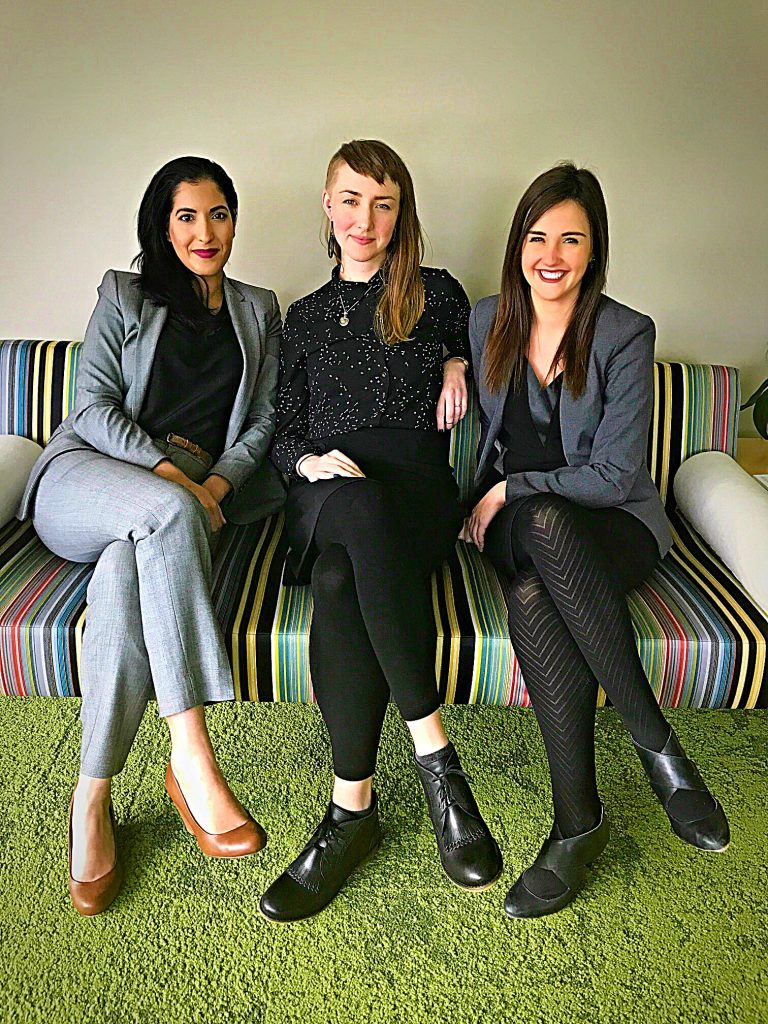Pictured: Balraj Dosanjh, Jaime Burnet and Nicola Watson (Photo by: Diane Slaunwhite)
I am a queer woman with tattoos, piercings, and a half-shaved head that have been part of my style for the past ten years. As an articled clerk and soon-to-be lawyer, working in a professional environment has been challenging in many ways – not the least of which is determining what it means to look the part.
As a law student, I received many messages about “professional attire” and how to “dress for success.”
For example, at a session about professionalism offered on campus, two white men included a picture of Nicki Minaj in their presentation as an example of “unprofessional attire.” This positioning by white lawyers before a group of largely white law students of a Trinidadian-born, Black American rapper as “unprofessional” was a loaded juxtaposition, and on top of that, was irrelevant. Nicki Minaj is not a lawyer. However, she is a professional. As a professional artist and entertainer, her choice of aesthetic is entirely appropriate.
Not long afterward, Canadian Lawyer posted a video entitled “Beauty gurus in law” on its website. The video reported on a networking event held in Toronto by the not-for-profit organization Young Women in Law. At the event, women were taught about skincare and makeup, and were “shown how to use various products to cover imperfections.” The Co-President of Young Women in Law explained to the interviewer that “it’s good to be professional just to show that image, to show that we’re serious, that we can do a good job.”[1]
I asked one of my professors how to navigate these messages we were receiving about our appearance, and what it purportedly said about our competence. How did we actually need to dress?
She told our class that, though we knew it was discriminatory to assume a person is less capable based on how they looked, we also had to face the reality that we would be representing clients, and our clients would be judged based on how we presented ourselves. She told us of an older judge who refused to listen to a woman make submissions in court unless she was wearing a skirt, because he believed it was inappropriate for women to wear pants.
These are only a few examples of how mainstream standards of professional dress, whether stated explicitly or perpetuated more subtly, are based on whiteness, class privilege, heteronormativity, and cissexism.[2] An article by genderqueer advocate Jacob Tobia explains the oppression inherent in the idea of professionalism:
“Professionalism is a funny term, because it masquerades as neutral despite being loaded with immense oppression. As a concept, professionalism is racist, sexist, homophobic, transphobic, classist, imperialist and so much more — and yet people act like professionalism is non-political. Bosses across the country constantly tell their employees to ‘act professionally’ without a second thought.
Wear a garment that represents your non-Western culture to work? Your boss may tell you it’s unprofessional. Wear your hair in braids or dreadlocks instead of straightened? That’s probably unprofessional too. Wear shoes that are slightly scuffed because you can’t yet afford new ones? People may not think you’re being professional either. For years, professionalism has been my enemy, because it requires that my gender identity is constantly and unrepentantly erased. In the workplace, the gender binary can be absolute, unfaltering and infallible.”[3]
Though the Nova Scotia Human Rights Act prohibits discrimination in employment on the basis of race, ethnicity, nationality, Indigeneity, religion, sex, sexual orientation, gender identity, gender expression, and disability, among other things, discrimination is not always overt. Often it is insidious and systemic, and can be difficult to prove.
When I began interviewing for articling positions with law firms, the messages I received in school and throughout my life made me worry that no one would hire me. Motivated by fear, I donned a skirt, nylons, a long-sleeved and high-collared shirt that covered all my tattoos, removed my facial piercings, and parted my hair on the other side of my head so as to appear more “professional,” less queer, and less weird. As uncomfortable as this was, it’s also important to note that my ability to fit myself within the oppressive standards that determine what constitutes a professional appearance is due to my unearned privilege as a white, thin, cisgender, able-bodied, middle-class person.
But fitting myself into oppressive notions of professionalism only serves to reinforce them, and I don’t want to be part of that. As a person with relative privilege, I also want to act in solidarity with people who are discriminated against in the name of professionalism in ways that I am not. When “professional” is being used as a code word for whiteness, class privilege, heteronormativity, and cissexism, it needs to be challenged and changed, whether through a human rights complaint, other legal action, or training and education. Collectively, we need to redefine what a professional looks like.
This post is written by our Articling Clerk Jaime Burnet
[1] http://www.canadianlawyermag.com/5840/Beauty-gurus-in-law.html
[2] The belief that cisgender people (those whose gender identity aligns in socially normative ways with their sex assigned at birth) are superior to transgender people (those whose gender identity is different from the gender that is normatively assumed to align with their sex assigned at birth).
[3] http://www.huffingtonpost.com/jacob-tobia/genderqueer-professional-_b_5476239.html

